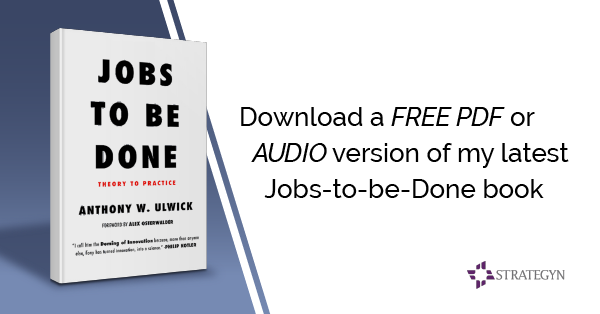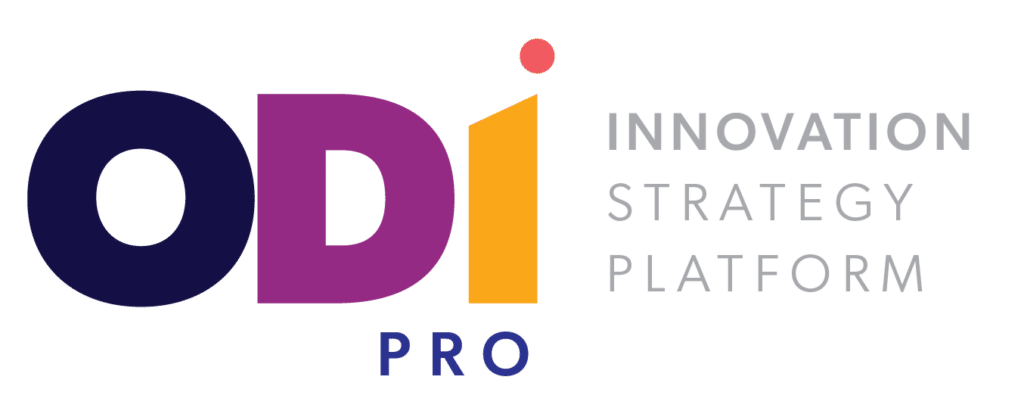Customer needs become discoverable and actionable when you define them around the job the customer is trying to get done.
Innovation appears to be a random, inherently unpredictable process. But what if we could understand the causal factors that contribute variability to the innovation process and learn how to control them? Would that bring predictability to innovation? The answer is yes — we have proven it can be done, but it requires new thinking.
Innovation is the process of devising product/service solutions that address unmet customer needs. There are 2 key inputs into the innovation process: (1) solutions: ideas for new products or product features that use new or existing technology in a new, unique or novel way, and (2) customer needs.
It is rare that we see companies struggle to generate ideas — in fact the opposite is usually true — they often have more ideas than they know what to do with. The reality is companies struggle with innovation because those responsible for conceptualizing, developing and evaluating ideas for new product/service offerings struggle with the “needs” side of the equation.
Our experience has led us to conclude that companies struggle with 5 key issues related to understanding and processing customer needs. These factors contribute significant variability to the innovation process. In nearly all our consulting engagements, we find that the members of the product team:
- Do not agree on what a “need” is or what types of customer needs exist.
- Do not agree on how a “need” statement should be constructed to effectively inform the innovation process.
- Do not know what all the customer’s needs are.
- Do not know which customer needs are unmet and to what degree.
- Do not know if segments of customers exist with different sets of unmet needs.
Clearly, if these issues cannot be resolved, the chance of devising a solution that effectively addresses the customer’s unmet needs is highly unlikely — thus making the innovation process appear random. But it doesn’t have to be that way. These issues can be resolved using the research methods we have devised as part of our innovation process, Outcome-Driven Innovation.
1. What types of customer needs exist?
Customer inputs must be captured that inform the development team what functions the product should perform, how customers want to interact with the product throughout its lifecycle, the emotional benefits they want to receive, and their financial goals and constraints. These types of inputs are detailed in the Jobs-to-be-Done Needs Framework (Figure 1).
Jobs-to-be-Done Needs Framework
The customer’s desired outcomes related to the core functional job inform product function. The desired outcomes associated with the consumption chain jobs done inform product lifecycle activities. Related jobs explore additional function that may be desired, while emotional jobs detail the desired emotional benefits. Lastly, the financial outcomes detail the customer’s financial goals and constraints. Each need type is defined in more detail in the book JOBS TO BE DONE: Theory to Practice.
2. How should a “need” statement be constructed?
A need statement must unfortunately be stated in words. Therefore those words must be organized in a sentence that communicates how the customer measures success and value when getting a “job” done. That same set of words must provide actionable input to the development team — in other words, it must inform the product function and design. The ideal “need” statement should also be stable over time and devoid of solutions — this means they must be associated with the job-to-be-done, not the product.
For these reasons, we structure a need statement as follows: Verb (minimize) + metric + object of control + contextual clarifier. For example, “minimize the time it takes to get the songs in the desired order for listening” is a desired outcome associated with the core job of listening to music. For all the details on structuring need statements go to Giving Customers A Fair Hearing (MIT Sloan article).
3. How do you collect all the customer’s needs?
Need collection begins with the creation of a job map. A job map breaks down the customer’s core functional job-to-be-done into discrete steps, detailing what the customer is trying to accomplish — independent of solution. The job map is created through customer interviews and refined throughout the qualitative research process. Additional details on job mapping can be found in the HBR article, The Customer-Centered Innovation Map.
The job map bounds the need-gathering process. With a job map in hand, the next step is to capture/create a complete set of desired outcome statements related to the core functional job. It is often the case that 5 to 10 outcomes are captured for each job step, and 100 or more desired outcomes statements are collected in total on the core job alone. Other statements (outcomes on consumption chain jobs, and also related and emotional jobs) add to the total.
A complete set of outcome statements for the core job will detail (in chronological order) exactly how customers measure success as they go about getting the job done step-by-step, from beginning to end. Outcome statements can be captured through customer interviews and ethnographic research, but they can also be extracted from literature, books or papers written on the subject.
4. How do you determine which needs are unmet?
A need is unmet when it is important to customers, but not satisfied with the products/services (or ad hoc solutions) they are using today. Knowing which of the 100 or more desired outcomes are most important and least satisfied pinpoints the opportunities for value creation.
Statistically valid quantitative research is required to determine which outcomes are underserved. First, we create a survey that includes the 100 or more desired outcome statements. Then we survey anywhere from 120 to 1200 customers (depending on a variety of factors), asking them to tell us the importance of each outcome and their current level of satisfaction. With these inputs we can determine which needs are most underserved (and overserved). See the HBR article Turn Customer Input into Innovation for more details.
5. How do you discover segments of customers with different unmet needs?
To discover segments of customers with different unmet needs you must segment the market using unmet needs (desired outcomes) as the bases for segmentation — not demographic, psychographic or other classification schemes. Companies rarely segment their markets in this manner because they cannot agree on what a need is, what the needs are and which are unmet. This is why so many innovation efforts fail.
In nearly every market we’ve analyzed over the past 25 years we discovered segments of customers with different unmet needs. This means that most markets are not homogeneous — and that a one-size-fits-all solution will rarely win in the marketplace. Outcome-based segmentation is critical to success.
We segment markets using the data collected in the quantitative survey. We first run factor analysis to discover which outcomes customers rate differently, and then run cluster analysis to place the customers into a predetermined number of segments. We then profile the segments to determine what unique complexities they face that cause them to have different sets of unmet outcomes. Learn more about our approach to segmentation in this white paper.
Once a product team knows precisely what unmet needs exist in an attractive, underserved segment of the market, it can apply its creativity to create a product that will deliver significant value to the customer. With the causal factors under control and a well-defined target in its sights, a product team is more likely to create a winning product.
This is how you bring predictability to innovation.







